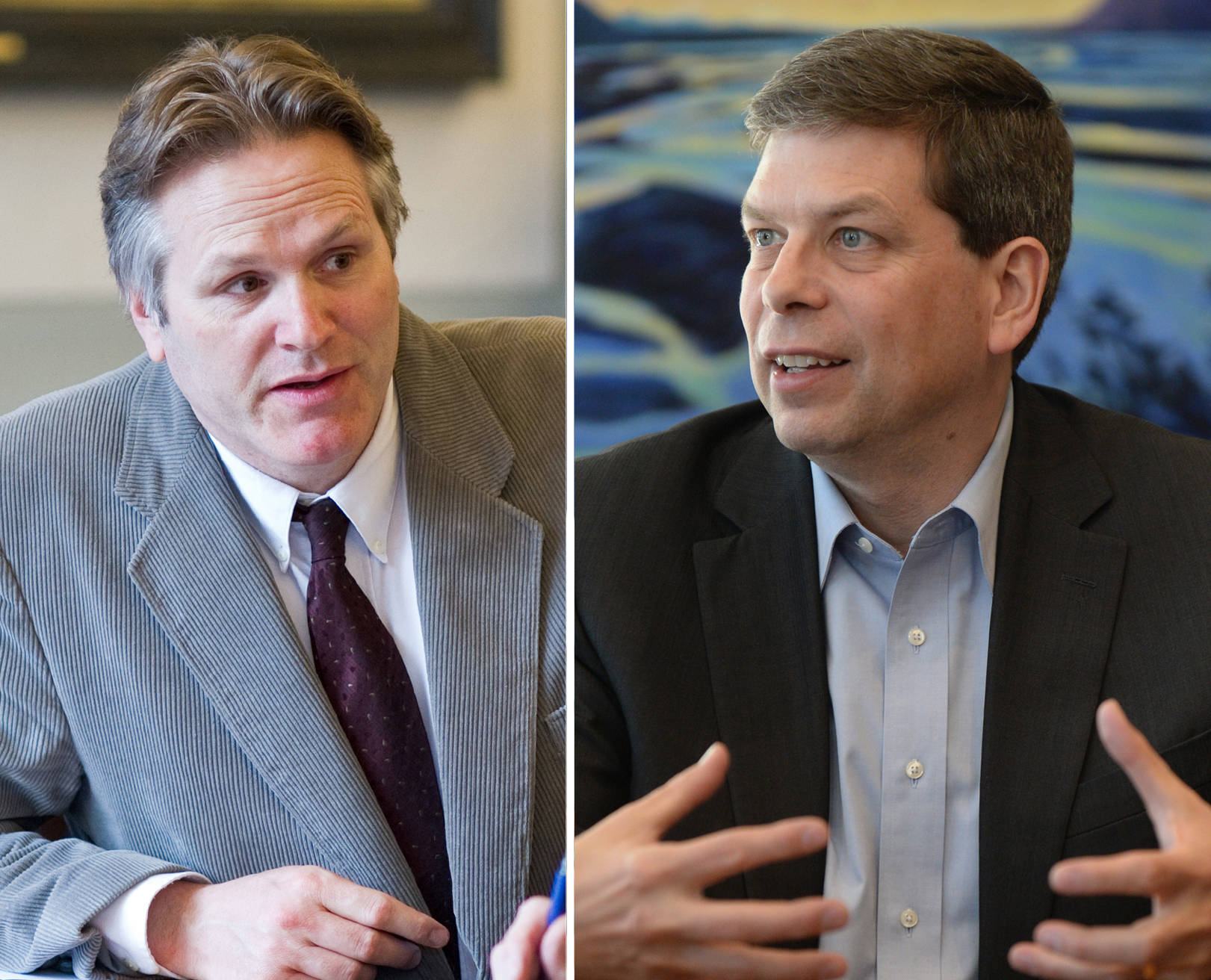With Gov. Bill Walker out of the picture, the gubernatorial race is closer than ever.
Mike Dunleavy still leads the race to become Alaska’s next governor, according to the latest poll released Tuesday, but Walker’s former supporters appear to be giving Mark Begich a boost in the race’s final two weeks.
The first poll of likely voters taken since Walker withdrew from the race on Friday shows Dunleavy leading Begich by four percentage points, 48 to 44. That’s less than half of the lead Dunleavy had when independent incumbent Walker and Democratic candidate Begich were competing for the attention of voters who want an alternative to the Republican frontrunner.
“I think it’s going to come down to the wire,” Ivan Moore, who owns firm Alaska Survey Research, said in an interview.
Walker’s withdrawal isn’t a pure benefit for Begich: According to Moore’s survey, not all Walker backers are choosing Begich over Dunleavy, and some intend to keep their votes with Walker, even after he quit the race.
The poll, performed by Ivan Moore of Alaska Survey Research, was conducted from among 500 likely or certain voters between Oct. 19 and Oct. 22. It has a 4.4 percent margin of error at a 95 percent confidence interval, was not commissioned by any of the campaigns, and was performed scientifically. Two weeks remain before Election Day.
By phone, Moore said he began polling Alaskans within “five to 10 minutes” of Walker’s withdrawal announcement Friday afternoon. Walker abandoned his campaign in an announcement Friday at the Alaska Federation of Natives conference in Anchorage, just days after the resignation of Lt. Gov. Byron Mallott, who made “inappropriate comments” to a female. It’s still unknown exactly what was said to the person.
The poll comes with an important caveat: In asking its questions, it deliberately stated that Walker has withdrawn from the race. That could sway the results of the poll, because Walker’s withdrawal came after ballots were printed, and not all voters may know of the withdrawal when they go to vote. His name will still appear alongside those of Begich, Dunleavy and Libertarian candidate Billy Toien.
Moore said the wording of the question was done out of necessity. He had seen the governor’s withdrawal speech on the internet, and some people saw it in person at the Alaska Federation of Natives Conference, but “aside from us folks, no one knew about it at that point,” he said.
That posed a problem for Moore, who wanted to begin the poll quickly. Without informing respondents, he risked getting a “kind of variable mish-mash through the fielding period” as more Alaskans learned about the news.
”What we would have gotten back was starkly different results between Friday and Monday,” he said.
Dunleavy has consistently led in polls of the four-way governor’s race (Moore’s polls have not included questions about Toien) through the summer. FiveThirtyEight, a website that takes a numbers-based approach to reporting the news, aggregates polls from a variety of sources. According to its estimate, Dunleavy had a 2-in-3 chance of winning the race after Walker’s withdrawal but before Moore’s poll.
Even after informing participants that Walker has withdrawn from the race, Moore’s poll shows some Alaskans will vote for the incumbent in the race. That could be significant in the final tally.
Endorsements shift
Alaska’s two largest labor organizations, the AFL-CIO and the National Education Association-Alaska, have shifted their support from Walker to Begich. The AFL-CIO announced their move Monday, and NEA-Alaska declared its switch Tuesday.
Dunleavy picked up some support as well. Incumbent Republican Rep. Don Young, R-Alaska, announced his support for Dunleavy, as did U.S. Sen. Dan Sullivan, R-Alaska and U.S. Sen. Lisa Murkowski, R-Alaska.
No do-overs
The Alaska Division of Elections will not allow absentee voters to change their vote if they turned in their ballots before Walker’s withdrawal announcement on Friday. According to division figures, 3,076 completed absentee ballots had arrived at elections offices by the end of the day Friday. The division said anyone who had voted an absentee ballot but not yet mailed it can contact the division for a replacement ballot.
Early voting figures
Division of elections figures show 3,007 Alaskans cast early votes Monday, the first day polls were open across the state. In Juneau, early votes can be cast at the State Office Building from 8 a.m. to 5 p.m., Monday through Friday. The elections office in the Mendenhall Mall Annex is also open for voting during the same times plus Saturday, Nov. 3, 10 a.m.-4 p.m., and Sunday, Nov. 4, noon-4 p.m.
Election Day is Nov. 6.
• Contact reporter James Brooks at jbrooks@juneauempire.com or 523-2258.

